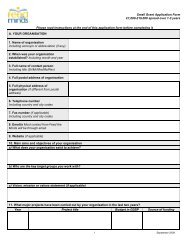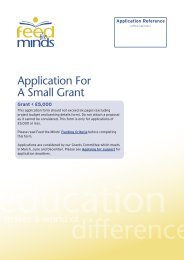Female Genital Mutilation practices in Kenya: - Feed the Minds
Female Genital Mutilation practices in Kenya: - Feed the Minds
Female Genital Mutilation practices in Kenya: - Feed the Minds
You also want an ePaper? Increase the reach of your titles
YUMPU automatically turns print PDFs into web optimized ePapers that Google loves.
aise awareness about <strong>the</strong> research, to pilot <strong>the</strong><br />
questions to be used and to enable <strong>the</strong> recorders<br />
from <strong>the</strong> partner organisations to develop <strong>the</strong>ir<br />
skills. These groups had up to 40 participants,<br />
from whom a cross-section of <strong>in</strong>dividuals were<br />
<strong>in</strong>vited to participate <strong>in</strong> <strong>the</strong> FDGs.<br />
In Kuria, ECAW organized FGDs and <strong>in</strong>terviews<br />
across <strong>the</strong> district; <strong>in</strong> Kisii, RWAYDO organised<br />
FGDs and <strong>in</strong>terviews <strong>in</strong> Kisii Central, Mosocho<br />
and Nyamira.<br />
dAtA collection<br />
And AnAlysis<br />
FGDs were conducted <strong>in</strong> Kisii and Kuria at venues<br />
accessible to <strong>the</strong> participants, facilitated by an<br />
experienced researcher <strong>in</strong>formed about FGM and<br />
expertise <strong>in</strong> qualitative research, <strong>in</strong>clud<strong>in</strong>g FGD<br />
facilitation. All FGDs were conducted <strong>in</strong> Kiswahili<br />
and <strong>the</strong> notes translated <strong>in</strong>to English. Before each<br />
FGD or <strong>in</strong>terview, <strong>the</strong> researcher expla<strong>in</strong>ed <strong>the</strong><br />
research to all <strong>the</strong> participants and obta<strong>in</strong>ed <strong>the</strong>ir<br />
consent to participate (see <strong>in</strong>formed consent forms<br />
<strong>in</strong> appendix B).<br />
As a qualitative study, data analysis was<br />
<strong>in</strong>terpretive, ra<strong>the</strong>r than statistical. Data was<br />
collated us<strong>in</strong>g a case study approach, construct<strong>in</strong>g<br />
brief m<strong>in</strong>i-cases <strong>in</strong> narrative form from each<br />
of <strong>the</strong> FGDs and <strong>in</strong>dividual <strong>in</strong>terviews, us<strong>in</strong>g<br />
<strong>the</strong> frameworks provided by <strong>the</strong> questions as a<br />
template (see appendix B). The m<strong>in</strong>i-cases were<br />
drafted with<strong>in</strong> a few days of <strong>the</strong> FGDs, whilst <strong>the</strong><br />
researchers were still <strong>in</strong> <strong>the</strong> communities. This<br />
enabled data verification to take place between<br />
<strong>the</strong> researcher, <strong>the</strong> recorders and at times <strong>the</strong><br />
respondents at this early stage.<br />
Once <strong>the</strong> m<strong>in</strong>i-cases were completed, larger,<br />
more comprehensive case studies were produced<br />
separately for Kisii and Kuria, draw<strong>in</strong>g on <strong>the</strong><br />
m<strong>in</strong>i-cases. These case studies were shared with<br />
<strong>the</strong> partner organisation support<strong>in</strong>g <strong>the</strong> research<br />
(ECAW <strong>in</strong> Kuria and RWAYDO <strong>in</strong> Kisii) to allow for<br />
fur<strong>the</strong>r data verification.<br />
reseArch APProvAl<br />
This study was approved by <strong>the</strong> <strong>Kenya</strong> National<br />
Council for Science and Technology, through<br />
Permit Number NCST/5/002/R/683/20. To obta<strong>in</strong><br />
clearance, <strong>the</strong> study proposal and data collection<br />
<strong>in</strong>struments were submitted for review by <strong>the</strong><br />
Council, along with <strong>the</strong> required fees. Ethical<br />
clearance was not required for <strong>the</strong> study, as it did<br />
not <strong>in</strong>volve under 18s, and did not <strong>in</strong>clude any<br />
<strong>in</strong>vasive procedures.<br />
limitAtions <strong>in</strong> <strong>the</strong> study<br />
Delayed start: Fieldwork was delayed due<br />
to delays <strong>in</strong> obta<strong>in</strong><strong>in</strong>g a research permit. The<br />
approval process took over a month to clear<br />
through <strong>the</strong> <strong>Kenya</strong> National Council for Science<br />
and Technology.<br />
Understand<strong>in</strong>g and use of <strong>the</strong> term,<br />
‘Alternative Rite of Passage’: When <strong>the</strong><br />
study was designed, it had been anticipated<br />
that FTM’s partners, ECAW and RAYDO, were<br />
support<strong>in</strong>g typical ARP programmes, where<br />
girls receive sexuality and life-skills tra<strong>in</strong><strong>in</strong>g and<br />
graduate <strong>in</strong> a public ceremony, complete with<br />
certificates. However, it was found dur<strong>in</strong>g <strong>the</strong><br />
community mobilisation that only <strong>in</strong> Kisii was this<br />
happen<strong>in</strong>g; <strong>in</strong> Kuria, <strong>the</strong> local agencies <strong>in</strong>stead<br />
run rescue camps, to which girls escape dur<strong>in</strong>g<br />
<strong>the</strong> circumcision period, receive tra<strong>in</strong><strong>in</strong>g and a<br />
certificate of graduation. However, <strong>the</strong>re is not<br />
always a public event to celebrate <strong>the</strong>ir com<strong>in</strong>g of<br />
age. Although <strong>the</strong> organisers of <strong>the</strong> camps used <strong>the</strong><br />
term ARP, local people did not appear to recognise<br />
<strong>the</strong> rescue camps as an alternative rite of passage.<br />
Mobilisation: This study used <strong>the</strong><br />
implement<strong>in</strong>g agencies to mobilise <strong>the</strong><br />
participants <strong>in</strong> <strong>the</strong> FGDs and <strong>in</strong>terviews. There is<br />
a possibility that <strong>the</strong> selection of participants may<br />
have been biased to <strong>in</strong>clude people with whom <strong>the</strong><br />
two agencies work closely, who are already<br />
aga<strong>in</strong>st FGM.<br />
ee<br />
15.




